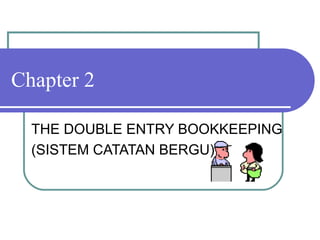
20100712160725 chapter 2 double entry system
- 1. Chapter 2 THE DOUBLE ENTRY BOOKKEEPING (SISTEM CATATAN BERGU)
- 5. THE ACCOUNTS FOR DOUBLE ENTRY The left hand side is called debit side; the right side is called the credit side.(T- account) Eg. If you paid RM10 by cheque for kettle, so debit the kettle account and credit bank account
- 7. In terms of asset, liabilities, and capital 1. To increase an asset we make debit entry. 2. To decrease an asset we make a credit entry 3. To increase a liability/capital account we make a credit entry 4. To decrease a liability/capital account we make a debit entry.
- 8. Debits and Credits If Debits are greater than Credits, the account will have a debit balance. $10,000 Transaction #2 $3,000 $15,000 8,000 Transaction #3 Balance Transaction #1 LO 2 Define debits and credits and explain their use in recording business transactions.
- 9. Debits and Credits If Debits are smaller than Credits, the account will have a credit balance. $10,000 Transaction #2 $3,000 Balance Transaction #1 LO 2 Define debits and credits and explain their use in recording business transactions. $1,000 8,000 Transaction #3
- 16. Answer…
- 18. Answer…
- 20. Answer…
- 22. Answer…
- 23. Combining all four transactions,
- 24. Answer…
- 25. REVIEW QUESTIONS a.Bought office machinery on credit from D Isaacs Ltd. b. The proprietor paid a creditor, C Jones, from his private funds. c. A debtor, N Fox, paid us in cash. d. Repaid part of loan from P Exeter by cheque. e. Returned some of office machinery to D Isaacs Ltd. f. A debtor, N Lyn, pays us by cheque. g. Bought van by cash. Account to be credited Account to be debited Complete the following table
- 26. End – Chapter 2
Notas del editor
- 1. On the topic, “Challenges Facing Financial Accounting,” what did the AICPA Special Committee on Financial Reporting suggest should be included in future financial statements? Non-financial Measurements (customer satisfaction indexes, backlog information, and reject rates on goods purchases). Forward-looking Information Soft Assets (a company’s know-how, market dominance, marketing setup, well-trained employees, and brand image). Timeliness (no real time financial information)
- Service Cost - Actuaries compute service cost as the present value of the new benefits earned by employees during the year. Future salary levels considered in calculation. Interest on Liability - Interest accrues each year on the PBO just as it does on any discounted debt. Actual Return on Plan Assets - Increase in pension funds from interest, dividends, and realized and unrealized changes in the fair market value of the plan assets. Amortization of Unrecognized Prior Service Cost - The cost of providing retroactive benefits is allocated to pension expense in the future, specifically to the remaining service-years of the affected employees. Gain or Loss - Volatility in pension expense can be caused by sudden and large changes in the market value of plan assets and by changes in the projected benefit obligation. Two items comprise the gain or loss: difference between the actual return and the expected return on plan assets and, amortization of the unrecognized net gain or loss from previous periods
